|
 Secure Site
Secure Site
|
 |
Archive for the 'Sleep Habits' Category
 how to get back to sleep One minute, you’re in the deep REM zone. The next, it’s 3 a.m. and you’re wide awake, eyes flung open, heart pounding, mind racing like a runaway train — “Will I meet that deadline?” “Did I turn off the stove?”
You lie there flustered, tossing and turning, until finally you give up — and spend the next few hours zoned out on the couch watching infomercials.
While you can’t ignore late-night anxiety, you can find calm by facing it head on. “Mindfulness makes you aware of the uncomfortable physical sensations that bubble up when your brain refuses to rest,” says stress and relaxation expert KRS Edstrom, creator of the Sleep Through Insomnia meditation CD. “It helps break up those I-can’t-fall-back-to-sleep thoughts, and lets your mind know it doesn’t have to panic anymore.”
When insomnia strikes, she suggests briefly getting out of bed (get a drink of water, gently stretch) to break the initial agitation. Then lie back down and, using the following visualization technique, focus your attention on how you feel. By observing the tension in your body, you’ll be better able to let it go and catch those precious remaining hours of rest.
Meditation How-To
1. Lie on your back, close your eyes, and take three deep, slow breaths through your nose.
2. Turn your attention to where the panic or tension resides in your body. Is it your head? Throat and neck? The pit of your stomach?
3. Observe the sensation. Does it feel dull, sharp, prickly, hot? Describe it to yourself objectively, without trying to make it stop or go away.
4. Now imagine drawing a circle around that spot with a marker.
5. Breathe deeply in and out for a few moments, watching the circle expand and shrink. Notice whether the intensity swells, plummets, or changes shape over time. As you relax, begin to envision the circle slowly melting away.
6. As the circle dissolves, let your body grow heavy; imagine that your bones are made of lead, sinking deeper and deeper into the bed. Feel a wave of relaxation flow over you, washing away your remaining anxiety, like sand being drawn out to sea.
7. Drift blissfully to sleep.
The Digital Zen Clock and Meditation Timer serves as a countdown and interval timer for yoga, meditation, bodywork, etc.; and it can also be set to chime on the hour as a tool for “mindfulness.”
adapted from Body + Soul Magazine, September 2008
 Natural Sounding Alarm Clocks, The Digital Zen Alarm Clock in Solid Walnut Now & Zen’s Meditation Timer Shop
1638 Pearl Street
Boulder, CO 80302
(800) 779-6383
Posted in intention, Meditation Timers, mindfulness practice, sleep, Sleep Habits, Well-being
Create a simple and restful nighttime routine for you and your children
 Create calm and relaxing bedtime rituals Sat Bir Khalsa, a Kundalini Yoga teacher who’s also an assistant professor at Harvard Medical School and a neuroscientist at the Division of Sleep Medicine of Brigham and Women’s Hospital in Boston is studying how a form of Kundalini Yoga breathing called Shabad Kriya helps people with insomnia, offers good news: “Treating the arousal should treat the insomnia.” By creating a routine of soothing rituals, you can bring your nervous system back into balance and transform your sleep patterns for good.
Rituals for Relaxing
Whether it’s yoga to reduce muscle tension, breathing to slow the heart rate, or an herbal massage to calm a racing mind, a hot bath to sooth your tired body, or a bedtime story to slow you and your children’s minds, creating a simple routine can be the most effective way to get a better night’s sleep. Maintaining consistency will help you and your children keep your circadian rhythms—the biological changes that happen every 24 hours—steady. Eventually, your body will naturally understand and crave sleep during these hours. Set your Zen Alarm Clock as part of your bedtime routine.
By Nora Isaacs Yoga Journal
Wake up refreshed, love your alarm clock, transform your mornings with The Zen Alarm Clock’s progressive awakening with gentle chimes.
“The Zen Alarm Clock,” uses soothing acoustic chimes that awaken users gently and gradually, making waking up a real pleasure. Rather than an artificial recorded sound played through a speaker, the Zen Clock features an alloy chime bar similar to a wind chime. When the clock’s alarm is triggered, its chime produces a long-resonating, beautiful acoustic tone reminiscent of a temple gong. Then, as the ring tone gradually fades away, the clock remains silent until it automatically strikes again three minutes later. The frequency of the chime strikes gradually increase over ten-minutes, eventually striking every five seconds, so they are guaranteed to wake up even the heaviest sleeper. This gentle, ten-minute “progressive awakening” leaves users feeling less groggy, and even helps with dream recall.
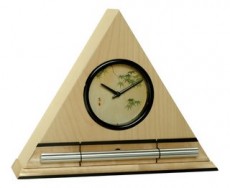 Zen Alarm Clock by Now & Zen Now & Zen – The Zen Alarm Clock Store
1638 Pearl Street
Boulder, CO 80302
Posted in Chime Alarm Clocks, Natural Awakening, Now & Zen Alarm Clocks, Progressive Awakening, Sleep Habits
 wake up naturally I recently taught my students about chronobiology—the study of cycles in organisms. We talked about the importance of a good night’s sleep, which is greatly aided by allowing sunlight and moonlight to synchronize our internal cycles. This means gradually awakening to morning sunlight and allowing our bodies to relax before bedtime by avoiding bright light.
Taylor had been troubled by insomnia. After this class, she was ready for a change. A few hours before bedtime, she turned off bright lights around the house and wrapped up her computer use for the day (the light from a monitor can throw off your biological clock). An hour before bedtime, she lit candles and turned off all electric lights. By candlelight, she bathed, got into her night clothes and meditated before falling into a deep, peaceful sleep. In the morning, she was awakened by the gradually increasing sunlight and her chime alarm clock with progressively increasing natural acoustic sound by Now & Zen. She came to class glowing with refreshment and a new sense of empowerment. Now Taylor understands that her body needs a relationship with natural cycles of light and dark. “I’m not nearly as groggy as I used to be,” she says. “Light really is stimulating!”
adapted from Natural Home Magazine, September/October 2009 by Carol Venolia
If you don’t have the luxury to gently wake up to by light — try the next best alternative…waking gently to soothing chimes. Out Soothing Digital Chime Clock’s long-resonating Tibetan bell-like chime makes waking up a beautiful experience – its progressive chimes begin your day with grace.
Carol Venolia is an eco-architect and co-author of Natural Remodeling for the Not-So-Green House (Lark Books, 2006). She teaches in the Sustainable Communities program at Dominican University of California.
 Gentle Chime Clock to help you Naturally Wake-Up Now & Zen’s Natural Chime Alarm Clock Store
1638 Pearl Street
Boulder, CO 80302
(800) 779-6383
Posted in Chime Alarm Clocks, Natural Awakening, nature, Progressive Awakening, sleep, Sleep Habits, wake up alarm clock, Well-being
 how to have get more energy When it comes to cultivating energy, you probably never did it better than when you were a toddler. You’d come barreling out of bed in the morning, eyes wide and arms full of toys. These days, you’re lucky if you can rouse yourself with multiple alarm clocks and a few cups of coffee. Snacks, if you have time to eat them, aren’t the healthy kind. As for naps and early bedtimes, they happen on rare, unplanned occasions, usually when you’re down with a cold or flu, or exhausted from running yourself ragged all week. With habits like these, it’s no wonder that more than one-third of Americans say they’re so tired that it interferes with work.
Depleted energy interferes with our lives. Feeling energetic “means having the vitality to do the things you want to do,” says Mark Hyman, M.D., editor-in-chief of the journal Alternative Therapies in Health and Medicine and author of “UltraMetabolism.” That vitality isn’t just a state of mind — it’s a physical condition. Each of our cells contains hundreds of mitochondria, tiny “power plants” that combine the oxygen we breathe with the food we eat and then burn the combination to create energy.
 increase vitality with a mindfulness practice We know this process as metabolism. How energetic we feel largely depends on how well our mitochondria are functioning. To function optimally, they need quality fuel: a wholesome, varied diet, restorative sleep, and plenty of oxygen from regular exercise. But rather than enhance our vitality, we often sabotage it with “counterfeit energy” — stimulants like caffeine that we think give us more pep but only drain our energy in the long run.
Getting your energy back is possible. Start by simply looking at your day. From morning until night, energy leaks abound. These daily habits may seem perfectly innocent, but over time they impair your body’s vitality.
Waking up in the morning should be as pleasant as falling asleep at night. The Zen Alarm Clock’s gradual, gentle awakening is transformative.
The Walnut Digital Zen Clock’s long-resonating Tibetan bell-like chime makes waking up a beautiful experience – its progressive chimes begin your day with grace. When the clock’s alarm is triggered, the acoustic chime bar is struck just once … 3-1/2 minutes later it strikes again … chime strikes become more frequent over 10 minutes … eventually striking every 5 seconds until shut off. As they become more frequent, the gentle chimes will always wake you up – your body really doesn’t need to be awakened harshly, with a Zen Clock you’re awakened more gradually and thus more naturally. Unlike artificial recorded sounds coming out of a tiny speaker in a plastic box, natural acoustic sounds transform your bedroom or office environment.
adapted from Body + Soul, September 2006
 gentle wake up clock with chime
Now & Zen’s Chime Alarm Clock Store
1638 Pearl Street
Boulder, CO 80302
(800) 779-6383
Posted in intention, Meditation Timers, Meditation Tools, mindfulness practice, sleep, Sleep Habits, wake up alarm clock, Well-being
 can yoga help you fall asleep? If you’re one of the millions of sleep-starved Americans with a dwindling supply of fence-jumping sheep, try introducing a few Downward Dogs to your bedtime menagerie. A recent clinical study at Boston’s Brigham and Women’s Hospital confirmed that bedtime yoga can help chronic insomniacs significantly reduce their tossing-and-turning time.
The results are most likely linked to yoga’s soothing effect on the central nervous system, says lead study author Sat Bir Khalsa, Ph.D., assistant professor at Harvard Medical School. In insomniacs, levels of the stress hormone cortisol are elevated,” he explains. Yoga can reduce cortisol levels, which is why you have that feeling of calm after practicing it.” And while the study’s poses were selected for their sleep-promoting effects (see below for instructions), Khalsa says most types of yoga, practiced regularly at any time of day, should bring on more nighttime ZZZs. Sleep-promoting yogic breathing exercises
 yoga exercises for insomnia Exercise 1
Sit with a straight spine, with your head erect and chin lightly tucked in. Extend both arms up to form a 60-degree angle (almost vertical), with wrists straight and palms and fingers extended flat and facing up. Keep elbows straight. Begin slow deep breathing through the nose. As you inhale, let your abdomen extend out as though it were being filled with air. As the inhale continues, let your chest expand. At the end of the inhale, pause briefly with your breath suspended; do not to lock your throat to hold the breath, but rather suspend the breath by lifting and suspending the motion of the chest. As you start to exhale, let the chest contract first. As the exhale continues, pull in your abdomen slightly as though it were being emptied of air. Pause briefly at the end of the exhale before beginning the next inhale. The breath rate should be four breaths per minute or slower (15 seconds or longer for each complete inhale/exhale). It is important that this breath, as with all of the breathing in these exercises, is done through the nose. Keep your eyes closed during this exercise, and focus your mental attention on the flow of the breath. Continue for 2 to 3 minutes using your zen timer in repeat mode. At the end, inhale deeply and hold for 10 seconds. Exhale, and let your breath relax as you keep your mental focus on the flow of the breath for about 1 minute with eyes closed.
 Yoga Timer & Chime Alarm Clock by Now & Zen, Inc. - Boulder, CO Exercise 2
Sit with a straight spine, with your head erect and chin lightly tucked in. Extend the arms out to the sides parallel to the ground. Bend the wrists with the fingers pointing straight up. (Your hands look like you’re pressing out toward two walls.) Begin slow deep breathing as described in Exercise 1. Continue for 2 to 3 minutes. At the end, inhale deeply and hold for 10 seconds. Exhale, and let your breath relax as you keep your mental focus on the flow of the breath for about 1 minute with eyes closed.
The Digital Zen Clock serves as a countdown and interval timer for yoga, meditation, bodywork, etc.; and it can also be set to chime on the hour as a tool for “mindfulness.”
 yoga for better sleep Exercise 3
Sit with a straight spine, with the head erect and the chin lightly tucked in. Press the palms together in front of the chest. The fingers of the right hand fingers go over the side of the left index finger and onto the back of the left hand. It is a “cross-lock” with the fingers crossing each other at 90 degrees. Squeeze the hands toward each other with continuous pressure. Begin slow deep breathing as described in Exercise 1. Continue for 2-3 minutes. At the end, inhale deeply and hold with a final push together of the hands for 10 seconds. Exhale, and let your breath relax as you keep your mental focus on the flow of the breath for about 1 minute with eyes closed.
Exercise 4
Sit with a straight spine, with your head erect and chin lightly tucked in. Place your hands in your lap, palms facing up, right hand over the left. The thumb tips touch and point forward. Keep the eyelids half closed. Look downward past the tip of your nose. Inhale in four equal segments through the nose. Mentally recite the sound scale, “Sah Tah Nah Mah”, with one syllable for each stroke of the breath. Then hold the breath by lifting and suspending the motion of the chest. As you hold the breath, mentally repeat the scale four times, for a total of 16 beats. Then exhale in two equal and powerful strokes out the nose. Mentally recite “Wah-Hay” on the first segment out, and “Goo-Roo” on the second stroke out. Continue for 5 to 31 minutes. At the end, inhale deeply and hold for 10 seconds. Exhale, and let your breath relax as you keep your mental focus on the flow of the breath for a few minutes. If you wake up in the night and have trouble falling back asleep, do this exercise for 5 to 11 minutes.
adapted from Body + Soul, April/May 2007
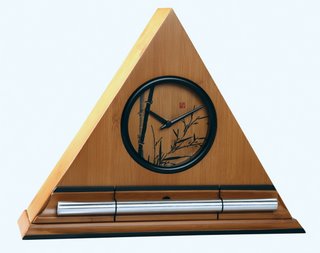 Bamboo Zen Clocks, progressive chime clock and timer for yoga Now & Zen’s Yoga Time & Chime Alarm Clock Shop
1638 Pearl Street
Boulder, CO 80302
(800) 779-6383
Posted in Insomnia, intention, Meditation Timers, mindfulness practice, sleep, Sleep Habits, Well-being, yoga, Yoga Timer, Yoga Timers by Now & Zen
 The Dream-Health Connection Physicians in early Egypt and ancient Greece encouraged people to recall their dreams when seeking medical advice. Mexican and Native American shamans have long considered dream interpretation important for both healing and spiritual awareness. Tibetan medicine views dream work as a path to self-discovery, an awareness that can help create an inner balance — and inner balance contributes to good health.
The Dream-Health Connection
Indeed, the study of dreams in relation to health is gaining acceptance in the scientific community. One study reveals that the role of REM sleep and noting dream variables may be significant in helping patients gain quicker remission from marital separation-related depression (Psychiatry Research, 1998, vol. 80). Other research finds that dream content reflects waking life stressors in people with insomnia. Several studies tracked cancer patients’ dream series and reported that their dreams may have pointed to early cues for the presence of the disease process.
Katherine O’Connell, Ph.D., a clinical psychologist, dream analyst and founder of the Dream Institute in Santa Cruz, Calif., says that “listening to dreams can save your life.” She notes that dreams not only reveal symbols for health issues that need to be resolved, but they often reveal the herbal remedy for the problem — a method of medical dream work that dates back to ancient Egypt and Greece. For example, O’Connell finds that her clients often dream of flowers or herbs that are traditionally used to treat the ailments their physicians diagnose.
In her dream-work journey, O’Connell has studied dream medicine with Tibetan lamas and researched 3,500-year-old Egyptian homeopathic remedies used for dream recall. Through the process, she has also collected more than 5,000 dreams — her own and those of clients — for analysis.
O’Connell believes that viewing your dreams as a series is the best way to understand the complete picture of your physical and psychological health. She suggests writing your dreams down, then reviewing common threads that run through them. “I see dream work as a good mystery story with many chapters,” she says. “With each chapter, we gain more clues along the way.”
Cultivating Dream Awareness
To access the clues in your dreams, start with your knowledge of yourself. While dream symbol books can serve as loose guides, dream interpretation is really an individual matter. For example, the color green may represent money to your spouse but symbolize healing energy to you. Likewise, a spider can be your personal symbol of creativity whereas it may signal a venomous threat to someone else; similar dream images often have different interpretations for different people. So it’s important to tap into your own associations, feelings and intuition about your dream symbols. “We have such innate wisdom. We must remember to trust ourselves,” O’Connell says.
Want to be more in touch with your dreams? ASD offers the following tips:
- Remind yourself to remember your dreams before you fall asleep.
- Keep a pad of paper and pen or tape recorder by your bedside. As you awaken to your chiming Zen Alarm Clock , try to move as little as possible and try not to think right away about your upcoming day. Instead, immediately write down your dreams and dream images, as they can fade quickly if not recorded.
- Influence your dreams by giving yourself pre-sleep suggestions. Before going to bed, write down your agenda. Or say aloud what you want to know to strengthen the conscious-subconscious dream connection.
- Forgo taking alcohol or stimulants such as coffee or caffeinated tea before bed, as these substances interfere with REM sleep. Also, try taking a warm bath with a few drops of chamomile or cedar essential oil (first diluted in a carrier oil such as almond or walnut), or try practicing a few minutes of meditation to clear your mind for restful sleep and clearer dreams. Dreams not only have the potential to enhance your health but, as Jungian analyst Marie-Louise von Franz says, “Dreams show us how to find meaning in our lives, how to fulfill our own destiny and how to realize the greater potential of life within us.”
Sweet dreams.
adapted from Delicious Living, October 2000 by Deborahann Smith
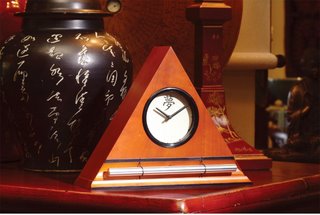 Zen Alarm Clocks with a progressive chime that doesn't interrupt your dreams Now & Zen – The Zen Alarm Clock Shop
1638 Pearl Street
Boulder, CO 80302
(800) 779-6383
Posted in Dreams, Japanese Inspired Zen Clocks, Natural Awakening, sleep, Sleep Habits, Zen Alarm Clock
 Insomnia Suggestions You’ve tried it all—chamomile tea, hot baths, aromatherapy, melatonin—and nothing works. Your insomnia obviously calls for something a little stronger than a glass of warm milk. In fact, you need something that packs a bit more punch, but you don’t want to resort to sleep medications. Good news: Sleep researcher Roger Cole, PhD, from Del Mar, California, recommends two powerful, natural sleep therapies that have helped many insomniacs drift off peacefully to dreamland.
Resetting your body clock
If you have difficulty falling asleep at night and waking up in the morning, try dawn/dusk simulation, a form of sleep therapy that resets your body clock. Your body uses natural signals, including sunlight and darkness, to trigger hormones that make you active in the morning and sleepy at night. Bright light, particularly morning sunlight, provides the strongest signal the body uses to regulate this hormonal cycle, called your circadian rhythm. So if you typically awaken before sunrise or work in artificially lit environments, your circadian rhythm may have gotten out of sync. Using a light box may help you reset it.
Here’s how to do it: Spend the first half hour of each morning in simulated “dawn,” by sitting in front of a light box. You can do this while you eat your breakfast, read the paper, or go about your morning routine. Before bed, spend time in simulated “dusk” by closing the curtains and keeping lights dim. This combination should reset your clock within a few days.
If sleep problems continue, wake up and use your light box a half hour earlier for a few days. Cole says eventually you’ll hit a “magic sleep spot.” Once you do, you should be able to discontinue the therapy. But people who are true night owls may need to keep using both dawn and dusk simulation indefinitely to stay on their new schedules.
Cole recommends a light box that delivers 10,000 lux at a distance of at least 20 inches. A large field of view (at least 18” wide) is a plus, and a box that gives white light with an extra boost of blue or blue-green may be more effective than a plain white box.
 sleepless nights call for solutions Sleep restriction
If you have trouble falling and staying asleep, and spend time tossing and turning, sleep restriction therapy may be the ticket. This therapy is based on the theory that although your body may have learned to get along without sleep, it’s actually possible for you to retrain it.
Start by estimating how much sleep you typically get each night, as opposed to how many hours you stay awake in bed hoping for sleep (say five hours of sleep for seven in bed). Stay in bed only for the amount of time you usually sleep (the five hours), scheduling your bedtime and wake-up time appropriately (say, 1 a.m. to 6 a.m.). Meanwhile, use your bedroom for sleeping only (and for, well, you know). And no fair taking mid-day naps.
If you do wake up during the night, lie awake in bed no more than 15 minutes. Then leave the bedroom, stay warm, and engage in a peaceful activity in a dimly lit room, returning to bed when you feel ready to sleep. And now—here’s the hard part—get up at your scheduled wake-up time (6 a.m., in our example), no matter what.
By the third or fourth night, you’ll be so exhausted that you’ll probably sleep through the night. Once you sleep well two or three nights in a row, increase your time in bed by 15 minutes—five hours and 15 minutes in our example. The extra minutes may cause some wakefulness again, so keep repeating your new schedule until you sleep soundly again for a couple of days. Then, you can add another 15 minutes, so you’re up to five hours and 30 minutes. Gradually work yourself up to seven hours of sleep (eight or nine may be unrealistic).
Obviously, sleep restriction requires self-discipline. But Cole reports that this therapy has been “experimentally proven to be as powerful as sleeping pills for helping insomniacs sleep, and is probably more powerful for the long term.” He does caution that sleep disorders can mask depression; if you notice other symptoms of depression, talk to your health practitioner before you try this therapy.
adapted from Natural Solutions Magazine, April 2006 by Nina Zolotow
 Gentle Awakening Alarm Clocks with Peaceful Chime Now & Zen – The Zen Alarm Clock Store
1638 Pearl Street
Boulder, CO 80302
(800) 779-6383
Posted in Chime Alarm Clocks, sleep, Sleep Habits
 Sleep Getting enough shut-eye doesn’t just boost your energy — it may increase brainpower as well. Research shows that a good night’s sleep helps improve memory. In one recent study published in Nature Neuroscience, researchers found that sufficient sleep is also necessary to help retain episodic memory — your ability to remember times, places, and events. Although sleep needs vary, most of us require about eight hours a night.
Waking up in the morning should be as pleasant as falling asleep at night. The Zen Alarm Clock’s gradual, gentle awakening is transformative.
The Digital Zen Clock’s long-resonating Tibetan bell-like chime makes waking up a beautiful experience – its progressive chimes begin your day with grace.
adapted from Body + Soul Magazine, 2010
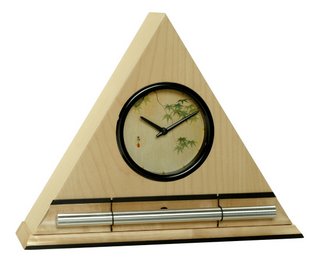 Japanese Maple Leaves Dial Face, the Zen Alarm Clock and Timer
Now & Zen – The Zen Alarm Clock Shop
1638 Pearl Street
Boulder, CO 80302
(800) 779-6383
Posted in Chime Alarm Clocks, sleep, Sleep Habits
 foot massage The senses can offer a shortcut to rest.
Massage comes to mind. So does aromatherapy; lavender essence in particular, small studies have shown, has a relaxing effect, even reducing stress hormone levels. Visual cues can raise or ease tension, depending on what you’re looking at. It’s a principle of design, for example, that horizontal lines are restful while vertical ones stir up power and tension (think a bed versus prison bars), and cool colors (blue, green) are said to induce more serenity than hot ones (red or orange). Views of nature have helped hospital patients heal faster. Gazing at an aquarium has been shown to slow the pulse.
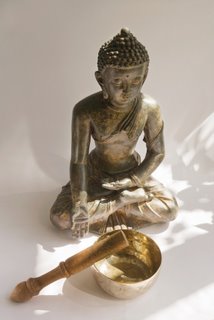 Carved Wooden Thai Buddha with Singing Bowl Sound, too, can be a potent relaxant, and tempo is a key player. Using various genres from classical to techno and rap, researchers found that, regardless of what music the subjects liked to listen to, an adagio (such as that from Beethoven’s Ninth Symphony) and an Indian raga physically decelerated the body into a calm state, compared with faster pieces like a Vivaldi presto (L’Estate) or a song by the Red Hot Chili Peppers. One reason for this may be respiratory entrainment, the tendency of the listener’s breath to rise and fall with the music’s beat. But another theory explains that putting on music—of any kind—can recharge you: When the tempo is brisk, it arouses our engagement; then when it slows or pauses, there’s a release of attention that leads to relaxation.
Lhasha Tizer, a wellness coach who teaches sound meditation at the Miraval Resort in Catalina, Arizona, believes that listening to nature’s sounds, a kind of music in itself, may have been the way our earliest ancestors meditated away stress. “Those rhythms create a trancelike state,” she says. (In fact, researchers at the University of Louisville School of Medicine found that a CD of natural sounds—birdsong, ocean surf—markedly shortened the amount of time it took people to physiologically recover from a stressful stimulus when compared with white noise.) “Today, with the way we work and the cacophonic noise we’re exposed to, we don’t have such an automatic gateway to help us focus and settle down,” Tizer points out.
To re-create that trancelike feeling through music, she suggests building up a sound repertoire. Start by being receptive to the sounds around you. Notice how noises affect you—children playing, horns honking, wind blowing through the trees. Gradually begin seeking out simple music with a clear percussive element. Pay attention to the beats you like, identifying the moods they evoke, and use those to guide you in choosing increasingly advanced melodies that carry away your anxiety.
In time, you’ll not only have a database of meditative music but, within it, be able to match your playlist to the mood you want to be in. Ultimately, a good rhythmic rest—and for that matter, any brief escape from a world where you always have to do to a place where you can just be—should make you feel like getting up and dancing.
Our Zen Timepiece’s acoustic 6-inch brass bowl-gong clock is the world’s ultimate alarm clock, practice timer, and “mindfulness bell.” It has the most beautiful natural Singing Bowl Sounds. It is not only an Alarm Clock by a Countdown timer for meditation and yoga.
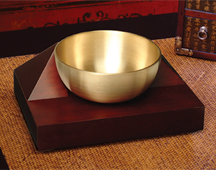 The Natural Sounds Singing Bowl Alarm Clock from Now & Zen, Inc.
It fills your environment with beautifully complex tones whenever it strikes. In the morning, its exquisite sounds summon your consciousness into awakening with a series of subtle gongs that provide an elegant beginning to your day. Once you experience the Zen Timepiece’s progressive awakening, you’ll never want to wake up any other way. It also serves as the perfect meditation timer. Available in 5 wood styles, including bamboo.
By Sara Reistad-Long
O, The Oprah Magazine
Now & Zen’s Natural Sounds Alarm Clock Shop
1638 Pearl Street
Boulder, CO 80302
(800) 779-6383
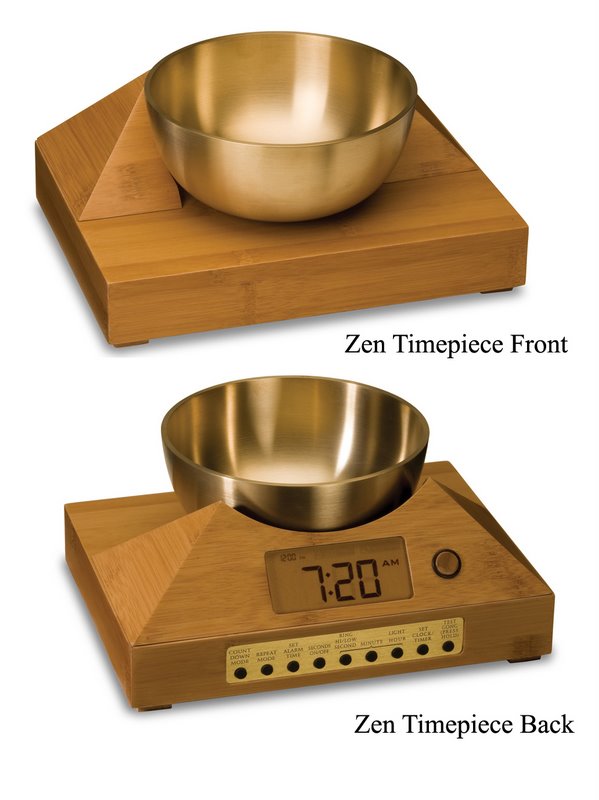 Sound Therapy Alarm Clock with Tibetan Singing Bowl
Posted in Natural Awakening, sleep, Sleep Habits
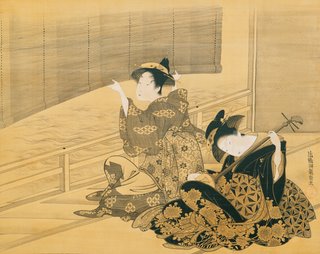 Isoda Koryusai, Japanese (active c. 1764–1788) Change Your Alarm Clock…
The Digital Zen Clock’s long-resonating Tibetan bell-like chime makes waking up a beautiful experience – its progressive chimes begin your day with grace. When the clock’s alarm is triggered, the acoustic chime bar is struck just once … 3-1/2 minutes later it strikes again … chime strikes become more frequent over 10 minutes … eventually striking every 5 seconds until shut off. As they become more frequent, the gentle chimes will always wake you up – your body really doesn’t need to be awakened harshly, with a Zen Clock you’re awakened more gradually and thus more naturally. Unlike artificial recorded sounds coming out of a tiny speaker in a plastic box, natural acoustic sounds transform your bedroom or office environment.
The Digital Zen Clock also serves as a countdown and interval timer for yoga, meditation, bodywork, etc.; and it can also be set to chime on the hour as a tool for “mindfulness.”
Digital Zen Clocks feature a “high” and “low” chime strike volume control, which allows you to adjust the sound of the chime to suit your needs. The Digital Zen Clock runs on 2 AA batteries (not included) and can also be plugged in with the included AC jack. The clock includes a lighted digital display (which can be set to be lit full-time when plugged in).
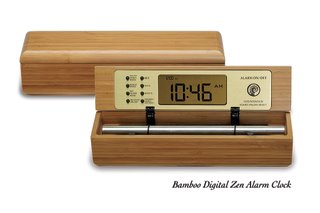 change your alarm clock so you eliminate the shock in your life Now & Zen’s Clock Store
1638 Pearl Street
Boulder, CO 80302
(800) 779-6383
Posted in Bamboo Chime Clocks, Natural Awakening, Now & Zen Alarm Clocks, sleep, Sleep Habits
« Previous Page — « Previous Entries
Next Entries » — Next Page »
|
|
|
|